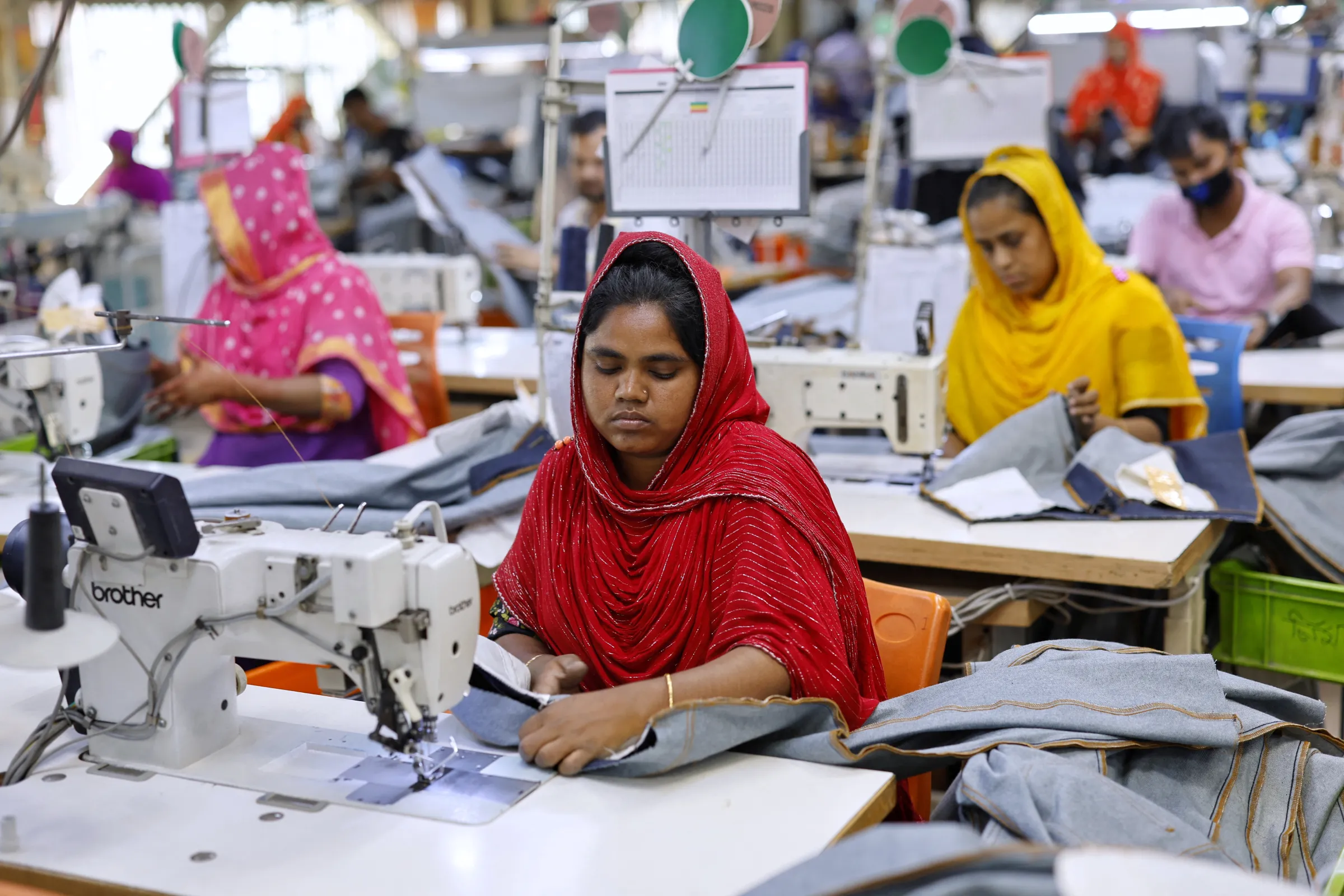Asian garment industry braces for higher U.S. tariffs

Bangladeshi garment workers make clothing in the sewing section of a factory in Gazipur, Bangladesh, April 9, 2025. REUTERS/Mohammad Ponir Hossain
What’s the context?
With new U.S. tariff rates, Asia's garment industry workers risk losing livelihoods as factories seek better deals.
- Bangladesh and Cambodia among countries getting revised tariffs rates
- Experts fear garment factories will move to neighbouring countries
- Women workers will be most affected
DHAKA/PHNOM PENH - Across Asia, unions and industry groups are raising alarms over the impact of higher tariffs by the United States on garment workers.
High tariffs might force companies to shut down or move to neighbouring countries that offer lower tariff rates, resulting in a loss of jobs, they say.
“The potential loss of jobs will cut the income and ability for workers to sustain their daily lives,” said Ath Thorn, vice president of the Coalition of Cambodian Apparel Workers' Democratic Union, which represents 80,000 workers across 40 factories.
Several countries in Asia have gotten notice of new tariff rates imposed by the United States to take effect August 1, after a 90-day pause on tariffs came to an end.
Manufacturing hubs such as Bangladesh and Cambodia will face high tariffs of 35 percent and 36 percent respectively, while neighbouring countries are still negotiating with the U.S. government.
U.S. President Donald Trump announced new tariffs through official letters posted on his social media platform, Truth Social, on July 8.
The U.S. is the largest garment export destination for Bangladesh. The country's exports to the U.S. totalled $8.4 billion last year and of that, garments comprised $7.34 billion.
Also in 2024, Cambodia exported nearly $10 billion worth of goods to the U.S., which accounted for nearly 40 percent of the nation’s total exports, according to government customs statistics.
More than half of U.S. imports from Cambodia were garments, footwear and travel goods such as luggage and handbags, a sector that makes up nearly half of the country’s export revenue and employs more than 900,000 workers.
Unions and industry groups warn that these workers could be hit hard with job losses if the high tariffs force companies to move to countries under lower tariff rates or shut down altogether.
While Cambodia is looking at a tariff rate reduction from 49 percent in April, anxiety permeates its garment industry, which employs hundreds of thousands of people and is one of the developing nation’s key economic pillars.
Meanwhile, the U.S. and Vietnam have struck a trade agreement that set 20 percent tariffs on Vietnamese goods.

U.S. President Donald Trump speaks to the media in the Press Briefing Room at the White House in Washington D.C., June 27, 2025. REUTERS/Ken Cedeno
U.S. President Donald Trump speaks to the media in the Press Briefing Room at the White House in Washington D.C., June 27, 2025. REUTERS/Ken Cedeno
With a neighbour next door with a significantly lower tariff, many companies may choose to leave Cambodia, said Yang Sophorn, president of the Cambodian Alliance of Trade Unions, which represents thousands of women who support their families as garment workers.
The fear is echoed by experts in Bangladesh, which faces a 35 percent tariff.
Selim Raihan, a professor of economics at the Dhaka University, said if tariff rates on Bangladesh’s competitors like India, Indonesia and Vietnam prove to be lower, Bangladesh would face a serious competitive disadvantage.
Such a disadvantage could make supply chain decision-making more difficult and erode the confidence of buyers and investors, Raihan told Context.
“As production costs rise and profit margins shrink due to the tariff, many garment factories may be forced to scale back operations or shut down entirely,” Raihan said.
In Bangladesh, the 35 percent tariff announced by the U.S. is more than twice the current 15 percent rates on Bangladeshi goods.
"With more than doubling tariff rates, can you imagine how the cost of the products will rise?" asked Mohiuddun Rubel, a former director of Bangladesh's garment manufacturers' association BGMEA and now additional managing director at textile maker Denim Expert Ltd.
The question is what happens to the tariffs for main competitor countries like India and Pakistan, said Rubel.
The U.S. is negotiating a trade deal with India, while reciprocal tariff rates for Pakistan have not been announced yet.

Bangladeshi garment workers works in the sewing section of a factory in Gazipur, Bangladesh, April 9, 2025. REUTERS/Mohammad Ponir Hossain
Bangladeshi garment workers works in the sewing section of a factory in Gazipur, Bangladesh, April 9, 2025. REUTERS/Mohammad Ponir Hossain
Outsized effect on women
Potential layoffs within the garment industry will have an outsized effect on women workers, which Sophorn said would cripple entire families.
“If these women lose their jobs because high tariffs force factories to shut, it will not only impact Cambodia’s economy, but now children may not be able to go to school and aging parents may not be able to afford medicine,” Sophorn said.
“The situation for women garment workers is already bad, but it will get worse if these tariffs were to come into effect.”
Many of the women she represents have taken bank loans to support their families and work in the garment industry to pay off their debts.
"If they lose their job, it means they will lose everything,” Sophorn said.
Tariffs would directly affect a sizable chunk of the four million workers in Bangladeshi's garment industry, most of whom are women from low income and rural backgrounds, Raihan said.
Thorn suggested Cambodia continue negotiations to get the tariffs down or find other ways to export more products, generate more income and create more work.
“If not, we will face problems,” he said.
(Reporting by Md. Tahmid Zami; Editing by Amruta Byatnal and Ellen Wulfhorst.)
Context is powered by the Thomson Reuters Foundation Newsroom.
Our Standards: Thomson Reuters Trust Principles
Tags
- Unemployment
- Wealth inequality
- Financial regulation
- Future of work
- Workers' rights
- Economic inclusion


















